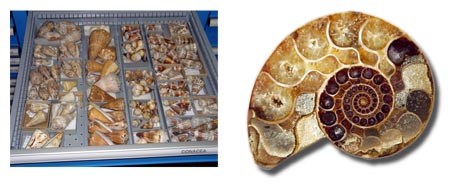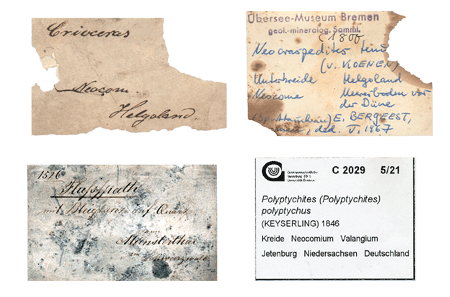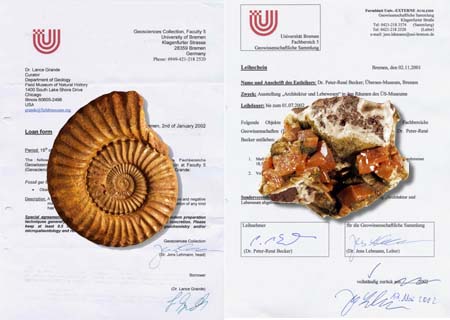Loan of material
Scientific loan
The Geosciences Collection is a collection for research and teaching that is also used for public affairs. The material can be loaned for scientific as well as for non-scientific purposes.

The material of the Geosciences Collection can be loaned for scientific studies at any time. The time span for a loan is one year, if necessary it can be prolonged. Any changes of the material, including the making of casts, needs a written permission by the head. The loan has to be picked up by the borrower personally, loaning by mailing the material is possible as an exception. Costs for insurances and mailing have to be paid by the borrowing person or institution. In case that a description, mention or photography of material of the collection is published, two reprints/mastercopies of the publication have to be provided to the Geosciences Collection after publication. Original labels will stay in the Geosciences Collection, if necessary these will be photocopied.

Abbreviation of the collection is GSUB (Geowissenschaftliche Sammlung der Universität Bremen am Fachbereich 5). The single groups of organisms respectively stratigraphic systems and crystal classes are encoded as follows:
Palaeontology and zoology collection
| Group | stem codes of fossils | stem codes of recent material |
| Arthropoda | A | a |
| Brachiopoda | B | b |
| Cephalopoda | C | c |
| Echinodermata | E | e |
| Gastropoda | G | g |
| Anthozoa/Porifera | K | k |
| Lamellibranchiata | L | l |
| Mikrofossils | M | m |
| Plantes | P | p |
| Scaphopoda | S | s |
| Vertebrata | V | v |
Stratigraphy-Petrography Collection
| Group | stem codes |
| Stratigraphic-Petrografic Collection | SPg |
| Stratigraphy Precambrian (after the German “Stratigraphie Präkambrium”) | SPK |
| Stratigraphy Cambrian (after the German “Stratigraphie Kambrium”) | SK |
| Stratigraphy Ordovician | SO |
| Stratigraphy Silurian | SSi |
| Stratigraphy Devonian | SD |
| Stratigraphy Carboniferous (after the German “Stratigraphie Karbon”) | SKn |
| Stratigraphy Permian | SP |
| Stratigraphy Triassic | STr |
| Stratigraphy Jurassic | SJ |
| Stratigraphy Cretaceous | SKr |
| Stratigraphy Tertiary | ST |
| Stratigraphy Quaternary | SQ |
| Stratigraphy drilling samples Tertiary (after the German “Stratigraphie tertiäre Bohrproben”) | STB |
Mineralogy Collection
The collection of minerals is subdivided into nine crystal classes.
| Group | stem codes |
| Elementes | 1 |
| Sulphides | 2 |
| Halides | 3 |
| Oxides and hydroxides | 4 |
| Nitrates, carbonates, borates | 5 |
| Sulphates, chromates, molybdates, wolframates | 6 |
| Phosphates, arsenates, vanadates | 7 |
| Silicates | 8 |
| Organic minerals | 9 |
A complete code in the Palaeontology-Zoology and Stratigraphy-Petrography Collection is as follows: GSUB followed by a space, a stem code and the serial number (without space). For example GSUB M1 is the first entry in the field of microfossils. In the mineralogy collection the stem code is followed by a dash and a serial number. If the person responsible for the collection has to be mentioned please
use the following:
Prof. Dr. Jens Lehmann
Head Geosciences Collection
University of Bremen
Faculty of Geosciences
Klagenfurter Strasse
D-28359 Bremen
Germany
Office Tel.: +49 421-218-65016
Collections Tel.: +49 421-218-65693
E-mail: jens.lehmann@uni-bremen.de

Loan for non-scientific purposes
The material might be borrowed for exhibitions or other public affairs on request. Borrowing for education in schools is possible in exceptional cases. Pickup of material is possible appearing in person only. Valuable specimens have to be insured by the borrower at an insurance company of free choice at the borrower’s expenses. The expertise for determining the insurance value is done by the head. The borrower is responsible for handling the material well and not to remove any accompanying labels and lettering on the specimens. The specimens will be packed for carriege and have to be packaged in a similar manner for returning. For public presentations a hint has to be given that the material is part of
the Geosciences Collection of the University of Bremen.
Contact: Prof. Dr. Jens Lehmann
